Essential oils are volatile, organic plant constituents that contribute to the fragrance and flavor of the plant. Distillation or cold pressing are used to extract them from plants.
Essential oils are used as insecticides, aromatherapy, personal care products (e.g., antibacterials), flavorings, herbal remedies, and liquid potpourri, among other applications.
So, do essential oil and cats go together?
Essential oils and cats rarely go together. Household pets, particularly cats, can be poisoned by essential oils. They are quickly absorbed through the skin and orally, and then metabolized in the liver. Cats lack an essential enzyme in their liver, which makes it difficult for them to metabolize and eliminate toxins such as essential oils. Cats are also sensitive to phenols and phenolic compounds found in some essential oils. The greater the risk to the cat, the higher the essential oil concentration (i.e. 100 percent). Although, not all essential oils are toxic to cats.
This article will talk about everything you need to know about the relationship between cats and essential oils.


Give Your Cat the Perfect Day
Get the Free Ebook!
What Are Essential Oils?
Essential oils are plant-based compounds that are extracted.
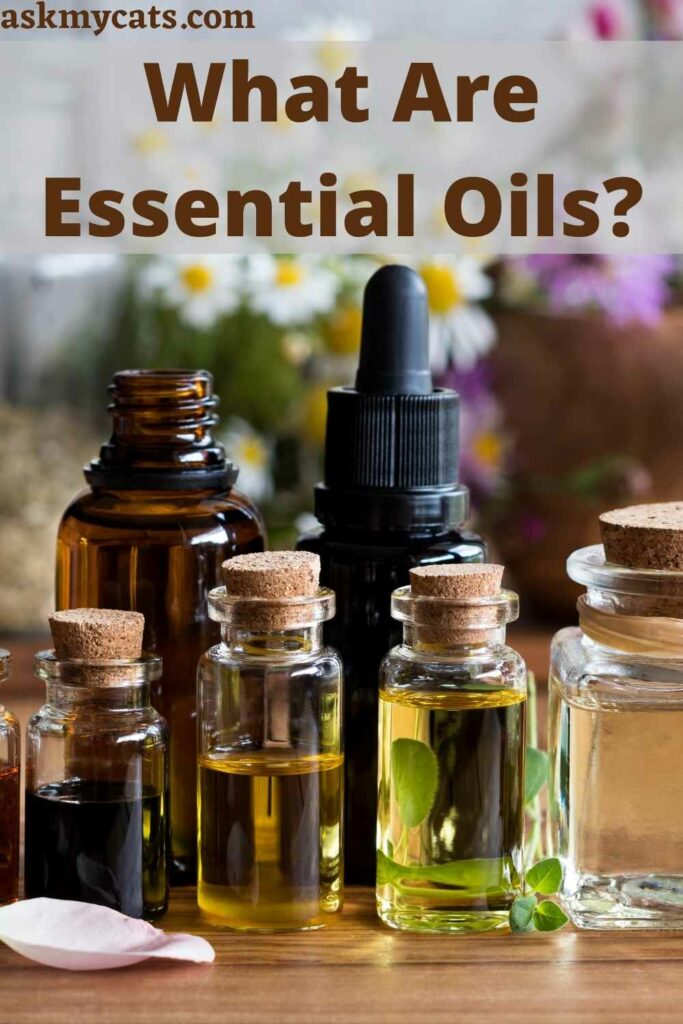
Aromatherapy, a type of alternative medicine that uses plant extracts to support health and well-being, frequently employs essential oils.
On the other hand, some of the health claims made about these oils are debatable.
Plant-based compounds that are extracted are known as essential oils. The oils capture the scent and flavor of the plant or its “essence.”
Each essential oil has its own distinct aroma due to its unique aromatic compounds.
Distillation (using steam and/or water) or mechanical methods such as cold pressing are used to obtain essential oils.
The finished product is made by combining the aromatic chemicals with a carrier oil after they have been extracted. Chemically extracted essential oils are not true essential oils, so the extraction method is important.
Distillation is the most common method for extracting essential oils, which is often done with steam. Expression, solvent extraction, sfumatura, absolute oil extraction, resin tapping, wax embedding, and cold pressing are some of the other processes.
They’re found in perfumes, cosmetics, soaps, air fresheners, and other products, as well as in food and drink flavoring and incense and cleaning products.
Essential oils should not be confused with perfumes, fragrances, or other similar products, as the latter typically contain pure chemical components, whereas essential oils are derived from plants.
Aromatherapy is a type of alternative medicine in which aromatic compounds are said to have healing properties. Essential oils are frequently used in aromatherapy.
Aromatherapy can help you relax, but there isn’t enough evidence to suggest that essential oils can effectively treat any condition.
Improper use of essential oils can result in allergic reactions, inflammation, and skin irritation, with children being particularly vulnerable to the toxic effects. If ingested or absorbed through the skin, essential oils can be poisonous.
Are All Essential Oils Safe For Cats?
No, all essential oils are not safe for cats.
Essential oils are having a moment, with applications ranging from cleaning and personal care to medical treatment and beyond. But what about your cat? Do essential oils exist for felines? Is it safe to use essential oils on cats?
In short, there are no safe essential oils for cats; they’re all potentially toxic to your feline companion. “In their concentrated form (100 percent), essential oils can absolutely be a danger for cats,” according to the ASPCA, including when the oil is applied to their skin, fur, or paws.
If you want to use essential oils in your home, you can take some precautions. One way to avoid toxicity is to use diffusers instead of concentrates. Note that diffused oil droplets can land on your kitty’s fur, which they will ingest when grooming.
Use a diffuser in an open space and keep the kitty away from it and its cords (note that diffused oil droplets can land on your kitty’s fur, which they will ingest when grooming). You can never be too careful when storing essential oils because cats are great at getting onto high surfaces and into small spaces.
Essential Oils That Are Safe For Cats
Although no essential oil is entirely safe for cats, if diluted heavily and taken the necessary precautions you can use the following essential oils: –
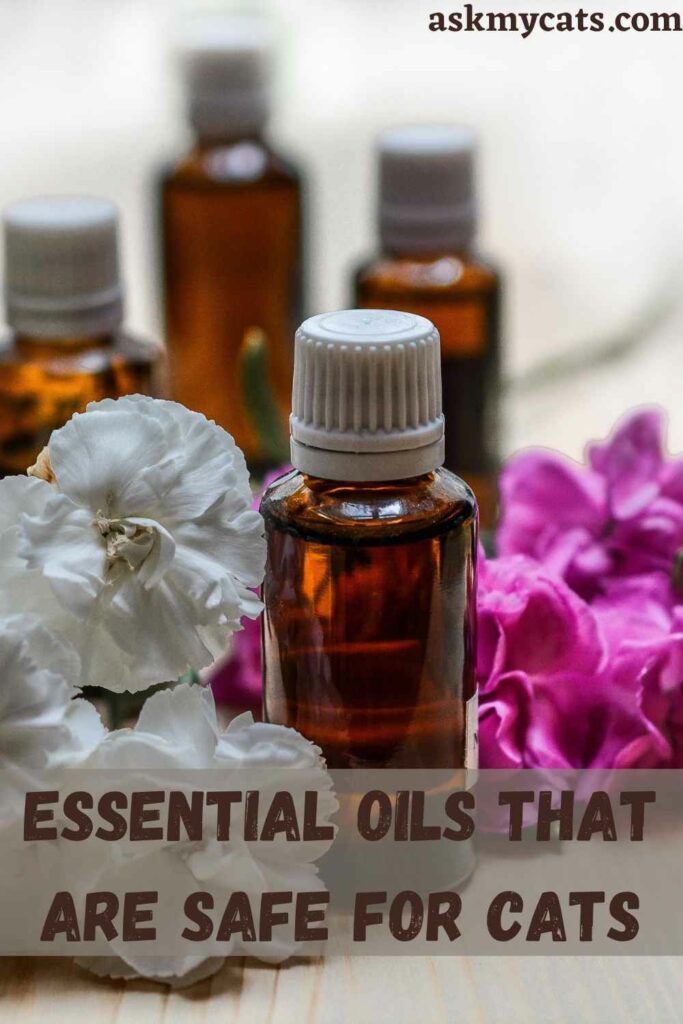
1. Cedarwood Oil
If used in moderation, cedarwood oil is safe for cats, newborns, and nursing mothers.
Cedarwood is not only safe for cats but has also been shown to be lethal to adult fleas.
To prevent future flea infestations, put a drop or two of cedarwood oil in your cat’s collar after you’ve given them a flea bath.
Cedarwood oil for cats may help to reduce the presence of fleas and other bothersome insects. Stressed cats may find it easier to relax and sleep as a result of this.
However, because there is limited data on the use of essential oils for pets, doing your research before deciding to use them is essential. For example, cedar oil comes in a variety of varieties.
When we say cedarwood essential oil for cats, we’re referring to cedarwood atlas essential oil. Other types of cedar oil can be extremely toxic to cats, which is why we recommend speaking with a veterinarian before using any oils. It’s also important to remember that cats should never be given essential oils.
If you have a cat, you might be wondering if you can use cedarwood oil around it. Many essential oils are extremely toxic to cats because their livers are unable to break down phenol, an organic compound found in plants.
Some essential oils have a higher concentration of phenol than others. Cedarwood oil is thought to be relatively safe for cats, despite the lack of evidence.
Make sure your cat can’t ingest the oil or come into contact with it. Also, make sure it’s heavily diluted, as strong scents are likely to make pets uncomfortable.
If you’re going to use cedarwood oil on your cat, make sure you dilute it first and don’t let your cat ingest any of it.
It’s crucial to know how to apply cedarwood essential oil to cats. Cats have a much stronger sense of smell than humans, as you may know.
Animals, on the other hand, have no way of expressing their dissatisfaction with something.
Always consult a veterinarian before introducing new things to your cat’s environment, and pay close attention to your cat.
the air by active diffusers, which can be harmful to your cat’s respiratory system. We want to make sure that we’re using cedarwood oil for cats responsibly. This entails a passive application of aromatherapy.
Reeds absorb the oil, and candles/warmers heat the oil, diffusing the scent mildly throughout the room, are examples of passive infusers.
To learn more about cedarwood oil and cats, check this out.
2. Lemongrass Oil
Lemongrass essential oil must be diluted before being used on cats, even if they are natural and 100 percent pure. To dilute your oils, you can use pure vegetable oil or other carrier oils.
Also, make sure you’re using therapeutic-grade essential oils. Use a 40:1 ratio to dilute your essential oils. To dilute one drop of essential oil, you’ll need 40 drops of carrier oil.
From ear to tail, apply a single drop of this diluted oil to your cat’s entire body. However, the most common way for cats to benefit from aromatherapy is to use a diffuser to diffuse essential oils.
While essential oils have been used on humans to improve health, they have also been used on animals to see if they have the same positive effects. Using essential oils in a diffuser has proven to be an effective method.
Start slowly and cautiously. We recommend diffusing 3-5 drops of lemongrass essential oil in a diffuser halfway or more filled with water at first.
Every pet is unique. Keep an eye on your cats while introducing essential oils to them. Keep an eye out for any behavioral changes or other issues.
Only therapeutic-grade essential oils should be used. If you bought expensive but low-quality products and used them on your cat, you’d have a lot of problems.
More information about the relationship between cats and lemongrass oil right here.
3. Lavender Oil
Lavender oil can help cats relax. It’s also perfectly safe to use as long as your cat doesn’t eat it.
Essential oils are popular among humans, but because cats metabolize them differently, they can be harmful to them.
Only a few are believed to be cat-friendly. Lavender, which has natural sedative properties, could help calm a nervous cat. Copaiba, helichrysum, and frankincense are also said to be safe for cats.
Before using essential oils around your cats, consult your holistic veterinarian for advice. Aromatherapy, such as lavender, can be used to help your cat cope with anxiety or stress.
You must, however, exercise extreme caution because many essential oils are toxic and potentially fatal. The sedative and calming properties of lavender are well known in humans. This oil can also be used to assist your cat in relaxing and calming down.
You could use lavender essential oil to calm your cat down if he becomes anxious before or during travel. For calming your cat during stressful events and situations like car rides, the geranium essential oil is a good alternative to lavender essential oil.
For a detailed guide on how lavender oil affects cats visit here.
Essential Oils That Are Toxic To Cats
Essential oils that are toxic to cats are:-
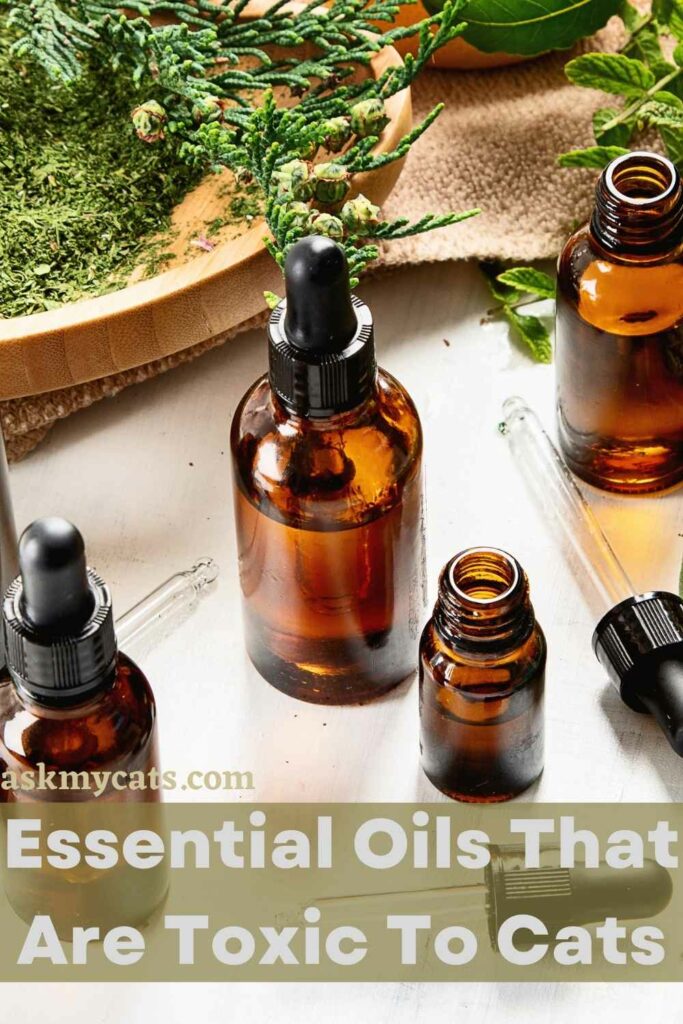
1. Chamomile Oil
Chamomile oil is not safe for cats because the essential oil in its concentrated form is far too potent to be used around cats.
If they ingest the oil, it could be fatal, and diffusing or using it in any other way around them could also make them sick.
Cats are toxic to chamomile essential oil because they lack the enzyme needed to break it down, which can lead to liver disease.
Essential oils are plant constituents that contribute to the fragrance and flavor of a product.
They’re both flammable and organic. Plants are distilled or cold-pressed to extract their constituents.
Essential oils are used in insecticides, aromatherapy, personal care products (such as antibacterials), flavorings, herbal remedies, and liquid potpourri, to name a few.
Cats are poisoned by chamomile essential oils. Before being metabolized in the liver, they are quickly absorbed through the skin and orally.
Cats have a hard time metabolizing and eliminating toxins like essential oils because they lack an essential enzyme in their liver.
Essential oils are toxic to cats because they contain phenols and phenolic compounds. The higher the concentration of essential oil, the greater the risk to the cat.
Drooling, vomiting, tremors, ataxia (wobbliness), respiratory distress, low heart rate, low body temperature, and liver failure are all symptoms that can occur depending on the amount of exposure.
If any of these symptoms appear, immediately take your cat outside and to a veterinary emergency center if the symptoms do not improve. The veterinarian may notice a low heart rate, low blood pressure, and signs of liver failure.
The risk to your cat increases as the concentration of essential oils rises. If your cat ingests oils by accident, get him or her to the vet as soon as possible.
Cats absorb essential oils such as chamomile that come into direct contact with their skin. Respiratory problems can be caused by inhaling diffused oils in the air.
They can also accumulate on your cat’s fur, causing him to eat them while licking and cleaning. Toxicity can appear suddenly or develop over time.
There are other ways on how chamomile oil can harm cats right here.
2. Clove Oil
Clove oil is harmful to cats. Clove oil is toxic when applied to the skin or diffused. Clove oil and pennyroyal oil (both of which are commonly used for natural flea control) have been linked to liver damage, vomiting, diarrhea, seizures, and other problems.
If your cat licked clove oil, contact your veterinarian right away and get her medical help.
The importance of getting a diagnosis and treatment as soon as possible cannot be overstated. Contact your veterinarian or the Pet Poison Helpline (800-213-6680), a 24-hour animal poison control center, if you suspect your cat has ingested clove oil. The sooner you get your cat’s medical help, the better the prognosis and outcome will be.
Don’t make your cat puke or give him activated charcoal. This could aggravate your cat’s condition. Put the product packaging in a sealed container and bring it with you to the veterinarian’s office. If any product gets on your skin or fur, wash it off with a liquid dishwashing detergent as soon as possible.
Clove oil contains chemicals that are quickly absorbed through the skin or through the digestive system. The liver is in charge of many of these chemicals’ metabolism.
Essential oils are particularly sensitive to cats because they lack the liver enzymes required to effectively metabolize them.
Furthermore, kittens and young cats, as well as cats suffering from liver disease, are more susceptible to their effects. The skin and mouth can be irritated or burned by clove essential oil.
Clove oil can be tricky to use around cats, for a more in-depth understanding be sure to visit here.
3. Eucalyptus Oil
Cats should avoid eucalyptus oil. Cats are extremely toxic to eucalyptus oil. When applied to the skin, diffused, or licked up in the event of a spill, it is poisonous.
Essential oils like eucalyptus oil have been shown to be toxic to cats in studies, whether taken internally, applied to the skin, or simply inhaled.
As a result of exposure, severe liver damage, liver failure, respiratory failure, seizures, and even death can occur.
Felines lack enzymes that allow them to properly process various compounds found in essential oils, particularly phenols (a process known as “gluconuridation”).
The liver is the organ most susceptible to failure because phenolic compounds are found naturally in plants and concentrated in essential oils.
Airborne essential oils from essential oil and aromatherapy diffusers, candles, liquid potpourri products, and room sprays can be inhaled or licked off their fur.
If you can smell oil, there is oil in the air, which can cause respiratory issues.
The following are some general guidelines for using eucalyptus oil in your home with your feline companions: –
- Eucalyptus oil should not be applied or fed to cats directly, nor should it be left in areas where they might come into contact with it. While some oils are insect repellent and smell great, your cat is at risk of serious or fatal reactions. It will be appreciated by your curious pet.
- If your cat has asthma, allergies, or other respiratory issues, avoid using eucalyptus oil.
- Keep cats away from rooms that have a lot of eucalyptus oil. Essential oil diffusers should not be used in rooms with kittens, elderly cats, or cats with liver or respiratory problems.
- If you still have any more queries about the relationship between eucalyptus oil and cats give this article a quick read.
4. Patchouli Oil
If your cat has consumed patchouli oil, it will exhibit symptoms of poisoning such as vomiting, stomach upset, and lack of coordination.
Look for signs of a lack of coordination. If your cat has been poisoned by patchouli oil, it may be unable to walk properly.
It might trace a crooked line across the floor, weaving this way and that, as if inebriated. In less severe cases, you may notice a general slowness of motion or a lack of energy.
Keep an eye out for tremors in your cat. Your cat may shiver or shake as a result of poisoning. In cats, essential oil poisoning can cause seizures, which are a very violent form of uncontrollable shaking.
Your cat’s seizure is a medical emergency, and you should contact your veterinarian as soon as possible.
Keep an eye on the temperature of your cat. When you notice tremors in your cat, they may or may not be linked to a drop in its core body temperature.
Take your cat’s temperature with a pet thermometer if you notice it shaking. Your cat’s body temperature is around 101.5 degrees Fahrenheit (39 degrees Celsius)
Examine your skin for any signs of irritation. Essential oil poisoning in cats can also cause skin irritation and redness.
This is especially true if the skin of the cat has been treated with essential oils. Swelling, bumps, blistering, or redness may appear on the lips, tongue, and gums.
Examine your cat’s eating habits to see if there are any problems. Patchouli oil poisoning could be the cause of your cat’s vomiting. You’re probably dealing with essential oil poisoning if the cat’s vomit smells like the essential oil he was recently exposed to. A sudden loss of appetite or disinterest in eating is a less serious symptom related to digestion.
Patchouli oil is very dangerous if ingested by cats, to know about what to do if a cat ingests patchouli oil click here.
5. Orange Oil
There is no known toxic dose of orange essential oil, according to experts. It depends on the sensitivity of each cat and the route of exposure.
Within the first three hours of exposure or ingestion, your cat may develop gastrointestinal symptoms. Blood tests for liver or kidney damage can take several days, according to experts.
If your cat has ingested orange oil, the following symptoms will appear: –
- Drooling
- Gastrointestinal signs such as vomiting and diarrhea
- Inappetance (refusal to eat)
- Lethargy
- Neurological signs such as staggering, stuporous or drunk like behavior, and tremors
- Decreased respiratory rate, asthma, or aspiration pneumonia
- Changes to heart rate/rhythm
- Liver failure
According to experts, inhaling essential oils can cause aspiration pneumonia. Aspiration pneumonia is a lung infection caused by foreign material inhaled into a cat’s lungs. Regurgitation or vomiting are the most common symptoms.
If your cat has come into contact with orange essential oil, experts advise bathing him right away to remove as much as possible.
Contact the ASPCA’s poison control hotline (888-426-4435) at any time of day or night for more information about the case.
They’ll be able to tell you whether it’s safe to keep an eye on your cat at home or if you should go to the nearest vet right away, as well as what you should do next.
After coming into contact with an orange oil/spray/diffuser, your cat may experience respiratory changes such as rapid breathing, coughing, and/or watery eyes. You should move your cat to a more open area and consult with your veterinarian.
If you wish to learn more about the effects of orange essential oil on cats, be sure to click here.
How To Use Essential Oil In A Diffuser?
Essential oil diffusers are electric devices that turn aromatic oils into diffused mists that fill the room with a fragrant aroma.
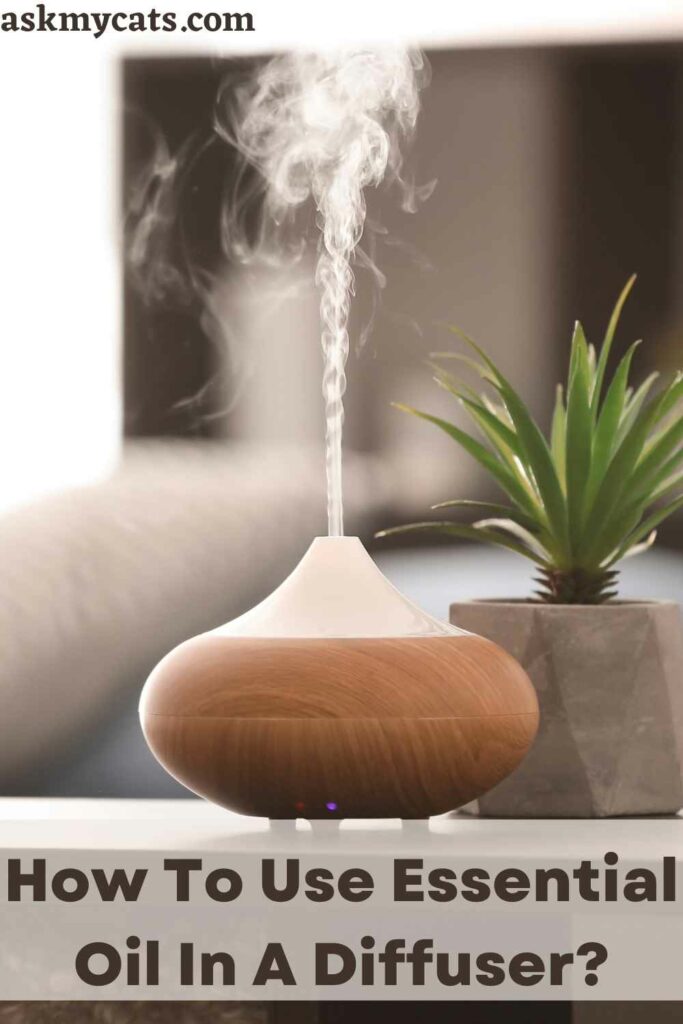
Diffusion and oil blending can be done in a variety of ways, so learning how to diffuse safely and properly will help you get the most out of your oils.
Clearly, there are numerous compelling reasons to invest in a high-quality essential oil diffuser and a collection of mood-enhancing scents, but you may be unsure of how the diffuser works or where to begin.
A standard electrical outlet is used to plug an ultrasonic oil diffuser into the wall, which causes a ceramic disc inside to vibrate.
The essential oils are broken down into teeny-tiny particles by this vibration, which is then blended with water and dispersed into the air as aromatic mist.
Don’t worry if it appears to be a little difficult.
A good essential oil diffuser will take care of everything for you, requiring very little setup and effort on your part. Most ultrasonic essential oil diffusers operate in a similar manner.
Here’s how to put one to good use: –
1. Set It Up
First and foremost, set it up! Your diffuser should be placed near a wall outlet. It’s a good idea to put it in your living room, bedroom, or anywhere else you like to unwind.
Place the diffuser at least two feet above the floor on a side table or nightstand, preferably on a tray. This will aid in the proper distribution of moisture in the air.
2. Fill Up The Tank
Because the diffuser relies on water to create a pleasant-smelling mist, you’ll have to refill it on a regular basis. The fill line on our diffuser is clearly marked, so you always know how much water to use.
Regular tap water should be avoided because it can cause mineral buildup inside the diffuser, reducing its ability to function properly over time. Use filtered water in your diffuser if possible.
3. Add The Oil
Now comes the exciting part: adding the essential oils! Remove the lids from all of your oils and take a big whiff of them. That section is entirely optional.
Add as many drops of oil as you want Depending on the strength, you’ll want to add anywhere from three to fifteen drops to a 100-milliliter diffuser, but don’t be afraid to experiment until you find the right amount.
4. Adjust The Settings
The beauty of modern essential oil diffusers is that they can be customized to fit a variety of needs. Ultrasonic Aroma Diffuser, for example, has two spray modes: pulse and constant stream.
It also has an LED light that provides soft illumination and, if desired, can be used as a nightlight. Finding your ideal settings may take some trial and error, but it will be well worth it once you find them.
Is Diffusing Essential Oils Harmful For Cats?
Yes, diffusing most essential oils are harmful to cats.

Cats are poisoned by many essential oils, including eucalyptus, orange, patchouli, and chamomile. Whether applied to the skin or used in diffusers, these are toxic.
Diffuser oil can still be harmful because it uses water vapor to diffuse tiny oil droplets into the air.
Inhaling diffused essential oil can cause aspiration pneumonia and other toxic effects if the diffuser is used in a small space or for a long time.
If you’re going to use a diffuser in your house, make sure it’s out of reach of your cat, and talk to your vet about which oils are safe to use.
If your cat has breathing problems, however, using a diffuser anywhere in the house is not a good idea.
You might want to think twice about using an oil diffuser if you have kittens or curious cats. Because cats have such a sensitive respiratory system, inhaled toxins have a negative impact on them.
Kittens and curious cats are known to knock over diffusers, spilling the oil. Toxic effects can occur if the oil gets on the cat’s fur (which it could ingest later while grooming) or if the cat licks the spill.
Keep in mind that cats are far more sensitive to odors than humans. What we consider a mild scent may be overwhelming to a cat. It’s possible that even if the essential oil you’re using isn’t toxic to pets, it’s too much for them.
If essential oils get on your cat’s skin or fur, wash it off with hand dishwashing soap as soon as possible. If you suspect your cat has consumed essential oil or is having a reaction to essential oil vapors, take your cat to the veterinarian right away.
Keep essential oils out of reach of curious cats at all times. Essential oils should never be left unattended because sweet-smelling liquids may tempt your cat.
Always consult a veterinarian before using essential oils on your cat. Consult your veterinarian to see if the oil you’re using in your diffuser is safe for your cat to use.
What Are The Benefits Of Essential Oils To Cats?
Although there are very limited benefits of essential oils, some of them are: –
- Essential oils such as lavender can help cats relax. As long as your cat doesn’t eat it, it’s also perfectly safe to use.
2. Only a few essential oils are thought to be safe for cats. A nervous cat might benefit from lavender, which has natural sedative properties. Cats are said to be safe around copaiba, helichrysum, and frankincense.
3. If your cat becomes anxious before or during travel, you can use lavender essential oil to calm him down.
4. Geranium essential oil is a good alternative to lavender essential oil for calming your cat during stressful events and situations like car rides.
5. Cedarwood oil is safe for cats, newborns, and nursing mothers when used in moderation. Cedarwood has been shown to be lethal to adult fleas as well as being safe for cats.
6. After you’ve given your cat a flea bath, put a drop or two of cedarwood oil in their collar to prevent future infestations.
7. Fleas and other bothersome insects may be reduced by using cedarwood oil for cats. As a result, stressed cats may find it easier to relax and sleep.
Risks Associated With Using Essential Oil On Cats
The risk associated with using essential oils on cats are: –
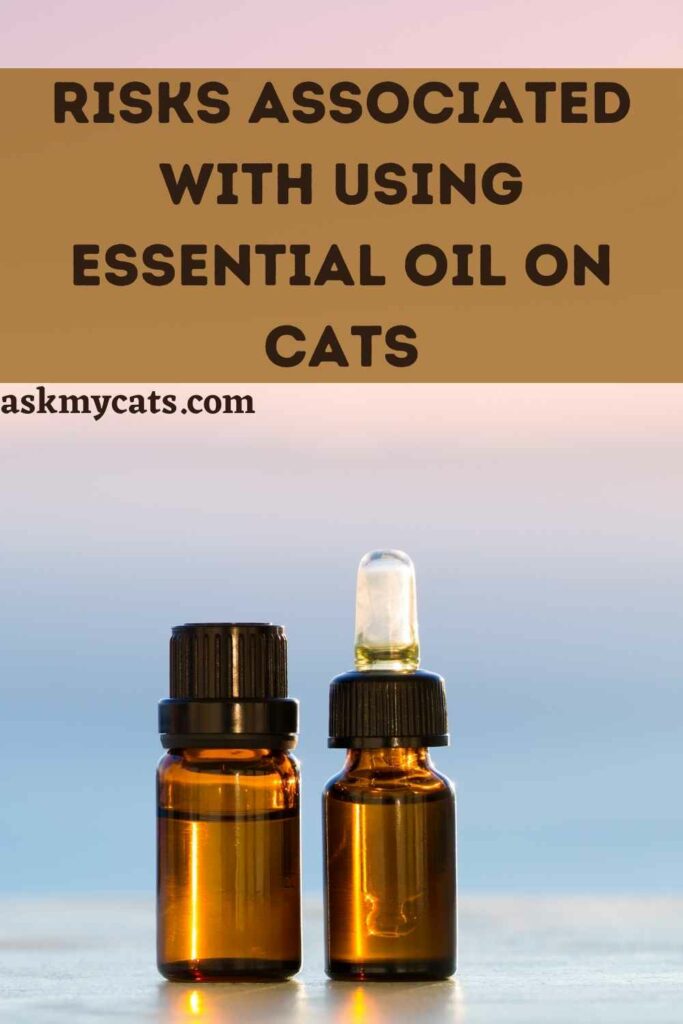
1. Essential oils can be toxic to cats if they come into contact with them on their skin, ingest them, or inhale them. Essential oils can cause serious organ damage in cats, including liver failure, seizures, and even death if they come into contact with them in these ways.
2. Essential oils should never be applied to your cat’s fur or skin. Your cat could lick the oil off their fur and swallow it as they groom, in addition to being absorbed through the skin.
3. Inhaling essential oils from reed diffusers or plugin diffusers can be hazardous to cats and have psychological consequences. However, because the oils are frequently diluted, the effects are uncommon. If your cat suffers from a medical condition like asthma, you should take extra precautions. It’s also best to stay away from essential oils that have been nebulized or ultrasonically diffused because the risk is higher.
4. Essential oils are sold and used in a wide range of concentrations. Some contain only 1 to 20% of the specific plant essence, while others contain up to 100% of the plant’s essence. When essential oils are used in higher concentrations, the risk of adverse effects increases.
Before using concentrated oils, make sure to dilute them properly. Furthermore, your cat’s sensitive skin, as well as the skin of other small pets such as rabbits, guinea pigs, and hamsters, may make them more prone to allergic or toxic reactions if essential oils are applied to or accidentally spilled on their skin.
5. Some cats may develop a watery nose or eyes, a burning sensation in the nose/throat, nausea leading to drooling and/or vomiting, and difficulty breathing after inhaling strong odors or fragrances. Labored breathing, fast breathing, panting, coughing, or wheezing are all signs of difficulty breathing in cats.
In cats, none of these symptoms are normal. Owners may mistake a coughing episode in a cat for the cat trying to vomit up a hairball. The cat, on the other hand, is crouched low to the ground in this case, with little to no abdominal movement, which is more typical of vomiting. There isn’t a single hairball to be found.
6. Cats with such symptoms should be moved to fresh air as soon as possible, and they should seek emergency veterinary care if their symptoms do not improve quickly. Cats with pre-existing respiratory issues, such as asthma or airborne allergies, or cats who are exposed to secondhand smoke from their human companions, are more likely to develop severe respiratory irritation.
Do Cats Like The Smell Of Essential Oils?
Whether or not a cat enjoys the scent of essential oil is entirely dependent on the cat and its personality.
Although it is clear that cats should not smell essential oils, it is rather vague when it comes to the question do cats like the smell of essential oil or not.
Essential oils aren’t on the list of popular scents that cats despise or that cats prefer.
This can be discovered by using essential oils in your home and near your cat. Check to see if your cat is purring and walking around near the diffuser. If you said yes, your cat enjoys the scent of the essential oil you’re using.
How To Dilute Essential Oils?
Combining 9 parts carrier oil with 1 part essential oil is the best way to dilute essential oil for cats.
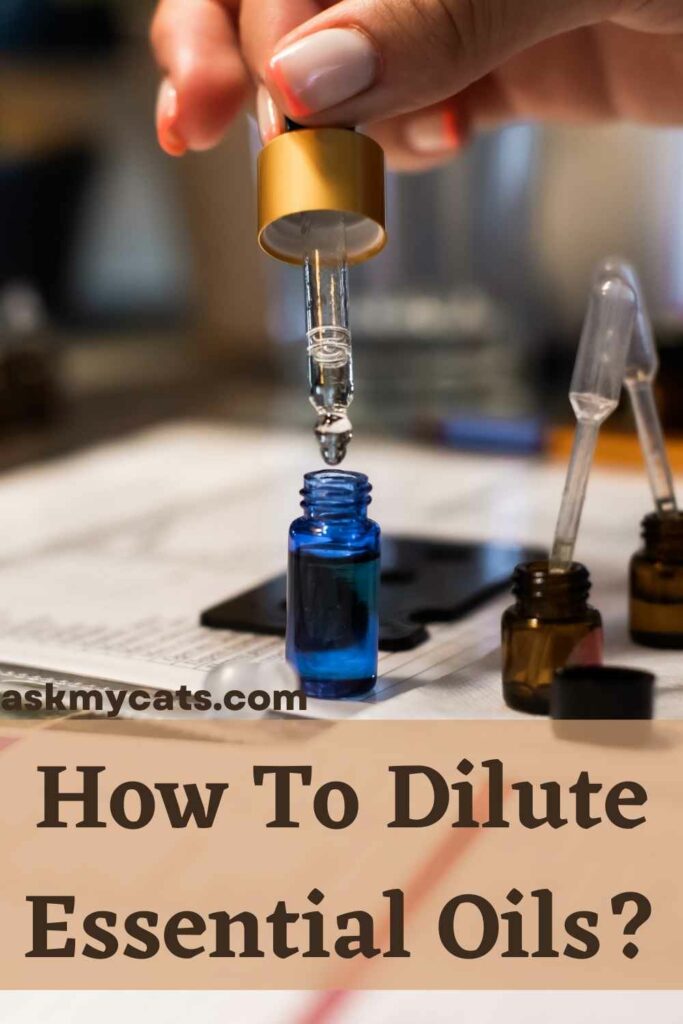
Before using essential oils topically on your cat, always consult your veterinarian.
This will keep you from using a product that could harm your four-legged friend by accident.
Essential oils are also toxic to cats and should not be given to them. This means you shouldn’t put it on your cat’s legs or paws, as it might get licked.
It’s also important to note that these oils must be diluted first. Use a carrier oil that you know is safe for cats, and if you have any questions, seek professional help.
When an essential oil has a dermal maximum of 2 percent or higher, a 2 percent essential oil dilution is generally considered a safe guideline for topical application of essential oils on adults, according to the second edition of Essential Oil Safety by Robert Tisserand and Rodney Young.
It is critical not to exceed the dermal maximum for an essential oil if the dermal maximum is less than 2%. Only use a 1% dilution for a kitten or the elderly cat. Use only essential oils that have been proven to be safe for cats when working with them.
When working with small amounts of essential oils, measuring by drop is the most convenient method. Unfortunately, due to the viscosity and temperature of the oil, as well as the size of the dropper or orifice reducer, one drop of one essential oil may be larger or smaller than another.
As a result, measuring essential or carrier oils by the drop isn’t the most precise method of measurement, but it’s fine for making small topical blends and recipes for cat use.
The most accurate method of measurement is by weight, rather than by drop or volume. For more precise blending and accuracy, measuring by weight is recommended.
Because the majority of those who read this article are new to working with essential oils and are unfamiliar with measuring out tiny amounts of essential oils by weight, focus on drop measurement.
How To Keep Cats Away From Essential Oils?
Follow these steps to keep cats away from essential oils: –
Keep your essential oils out of the reach of your cat. Cats are explorers by nature. If your cat ingests, inhales, or comes into contact with concentrated essential oils, poisoning will be more rapid and severe. As a result, keep your essential oil out of reach of your cat in a high, out-of-the-way cabinet.
Seal your essential oil bottles in a resealable plastic bag and store them in a locked cabinet if they emit a strong scent even when not sprayed. Essential oil should be avoided by your cat.
If you’re going to spray essential oil in the room, keep your cat out of it and don’t let it back in until the scent has faded. Oils should not be used for more than two weeks at a time to avoid low-level buildup.
Wait at least one week before using essential oils again. By opening a window or turning on a fan, you can hasten the dissipation of essential oils.
Can Essential Oil Help In Flee management In Cats?
Yes, essential oil like cedarwood oil can help in flee management in cats.
One of the most common problems that cats face is pests. Flies, moths, and fleas are just a few of the annoyances that our four-legged friends face on a daily basis.
According to research, the use of cedarwood essential oil for cats has shown some promise in terms of acting as a deterrent to these insects.
After you have given your cat a flea bath, try adding a drop or two of cedarwood oil into their collar in order to prevent future flea infestations.
Scratching and itching can indicate your cat has fleas, but they can also indicate a variety of other issues.
It’s critical to seek advice from a veterinarian to ensure you’re not overlooking something more serious. Cedarwood oil for cats can be used for aromatherapy as well as topical application to kill fleas on your cat.
How Your Cat May Be Exposed to Essential Oils?
Your cat may be exposed to essential oils by: –
Your cat may be exposed to essential oils that you use for yourself. Keep any essential oils in a cat-proof cabinet out of reach of your curious pet.
Passive reed diffusers or potpourri pots can be knocked over, exposing your cat to the oil-containing liquid, which can be ingested or absorbed through contact on its skin or fur. Do not allow your cat to lick your skin if you have used essential oil-containing products.
Diffusers of essential oils and aromatherapy, candles, liquid potpourri products, and room sprays are all sources of airborne essential oils that cats can inhale, causing respiratory irritation. There is oil in the air if you can smell the fragrance of the oil, and it can affect your cat.
Kittens, elderly cats, and cats with liver or respiratory issues should be kept out of rooms with essential oil diffusers. When you’re around your cat, avoid wearing aromatherapy jewelry.
Can You Safely Use Essential Oils Around Cats?
Yes, you can safely use essential oils around cats.
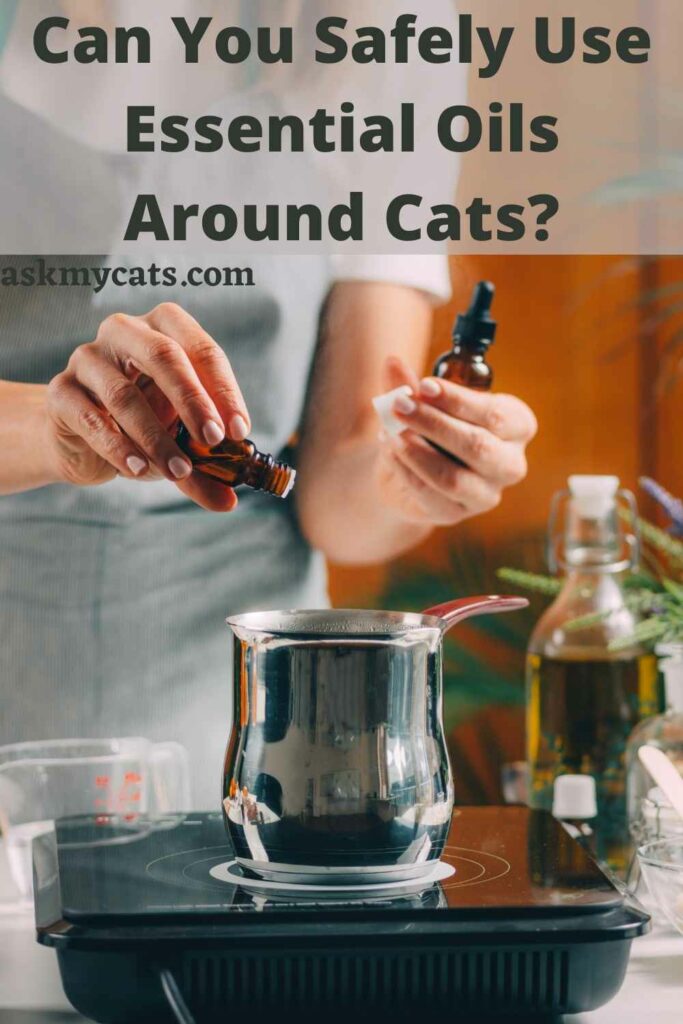
Essential oils may smell wonderful—after all, who doesn’t enjoy a scent-infused bath bomb or an energizing fragrance diffused into the air?
However, because many essential oils can be harmful to cats in the home, it’s critical to use them with caution around your feline companion. What is the first rule? Take precautions.
The best way to avoid exposing your cats to dangerous substances, according to experts, is to always err on the side of caution and ‘pet-proof your space.
The following are the guidelines for minimizing the risk to cats to help cat parents create a safe space for cats and essential oils to coexist: –
Cats and other animals should not be exposed to highly concentrated oils. Because it’s difficult to know how diluted or concentrated essential oil is. Expert advises against using it on cats due to the variability in concentration and quality, it’s best to completely avoid directly applying them to your cat.
If your cat or other pet has underlying health issues, especially respiratory issues, avoid using essential oil diffusers. Diffusers should never be used near birds, who are especially sensitive to breathing problems.
Keep essential oil bottles, diffusers, and warmers out of reach of cats.
Allow cats to easily exit a room if the smell of a diffuser or warmer is too strong for them. While cats’ sense of smell isn’t as acute as that of dogs, it is more acute than yours.
Diffusers should be kept away from areas where cats or other animals groom themselves. Diffusers and warmers release essential oils into the air, where they can settle on a cat’s fur.
Keep essential oils away from your cat’s fur and skin. You should be fine if you use diffusers and warmers in rooms without cats for short periods of time.
When Should You Call The Vet?
Contact your vet or an emergency clinic immediately if you suspect your cat has ingested an essential oil.
According to the Pet Poison Helpline, symptoms of essential oil poisoning include difficulty breathing, coughing, wheezing, drooling, vomiting, tremors, wobbliness, and a low heart rate.
If you suspect your cat has ingested an essential oil, contact your veterinarian or an emergency clinic right away, and stop using any essential oil that causes irritation or discomfort for your cat.
Consult your veterinarian before using essential oil products or diffusers in your home to ensure your cat’s health and safety.
What Studies Have Been Done On Long-Term Effects Of Essential Oils On Cats?
Unfortunately, there is not enough research that has been done on the long-term effects of essential oils on cats.
There is a scarcity of data on the effects of many essential oils on the health of cats. As a result, people frequently rely on their feelings rather than facts.
Some argue that essential oils are relatively safe because there has been no increase in hospitalization as their popularity has grown.
Others claim that the side effects of their use may be subtle and cumulative at lower levels of exposure, and they conclude that the safety data is insufficient for the purposes of safety assessment. There have been several reported cases of direct oil exposure causing harm or even death.
There is very little experimental data on the toxicity of essential oils to cats that have been published. This is due, in part, to the wide range of essential oils, a lack of funding for such studies, and the ethics of exposing animals to potentially lethal substances.
Data on chronic or low-level exposure is even more scarce. As a result, much of the evidence is based on case reports or theoretical toxicity based on chemical properties.
Frequently Asked Questions
How hazardous are essential oils and liquid potpourri to cats?
Chemicals in essential oils and liquid potpourri are quickly absorbed orally or through the skin. Many of these chemicals are broken down by the liver. Cats are especially sensitive to essential oils because they have a lower number of certain liver enzymes that are required to effectively metabolize these oils.
Furthermore, very young cats and kittens, as well as cats with liver disease, are more vulnerable to their effects. Some essential oils and liquid potpourri can also irritate or burn the skin and mouth. Depending on the ingredients in a specific product and how the cat is exposed, a couple of licks or a small amount on the skin could be harmful to a cat.
Cats can be exposed by tasting simmering liquid potpourri or coming into contact with liquid from leaking or overturned containers. Cats are obsessive self-groomers, so if these products get on their skin, they are likely to be consumed.
How To Blend Essential Oils?
It’s somewhat of an art, one that takes lots of trial and error. But it’s definitely one you want to learn how to master, especially if you want to create completely customized scents for your cat. To get started, invest in a collection of pure essential oils that you can mix to create one-of-a-kind aromas (sometimes called synergies or blends).
Choose scents that complement one another in terms of both the scent’s qualities and the feeling it elicits—for example, if you’re going for something soothing, don’t pair calming chamomile with uplifting lemon. There are lots of readily available essential oil recipes you’ll find online. Always refer your vet before blending essential oils for your cat.
Can Cats Breathe In Essential Oils?
Essential oils should not be given to cats because they can cause a variety of problems, including liver damage. Essential oils, whether taken internally, applied to the skin or simply inhaled, can be toxic to cats, according to research. Exposure can cause severe liver damage, liver failure, respiratory failure, seizures, and even death.
Final words
Essential oils are difficult to use in a way that is completely safe for your cat, and there are numerous risks to consider. If you choose to use them, you must exercise extreme caution and remain vigilant at all times. Consult your veterinarian before attempting to use essential oils – your cat will thank you!
The risks of using essential oil in your home outweigh the benefits, particularly if you have curious cats. It is recommended that you proceed with caution. The type of essential oil, the dosage, and the route of administration are all important factors to consider.
And, regardless of which essential oil or diffuser you choose, consult with our veterinarians, do your research, and proceed with caution.
If you have any unanswered questions, ask us in the comments sections.
